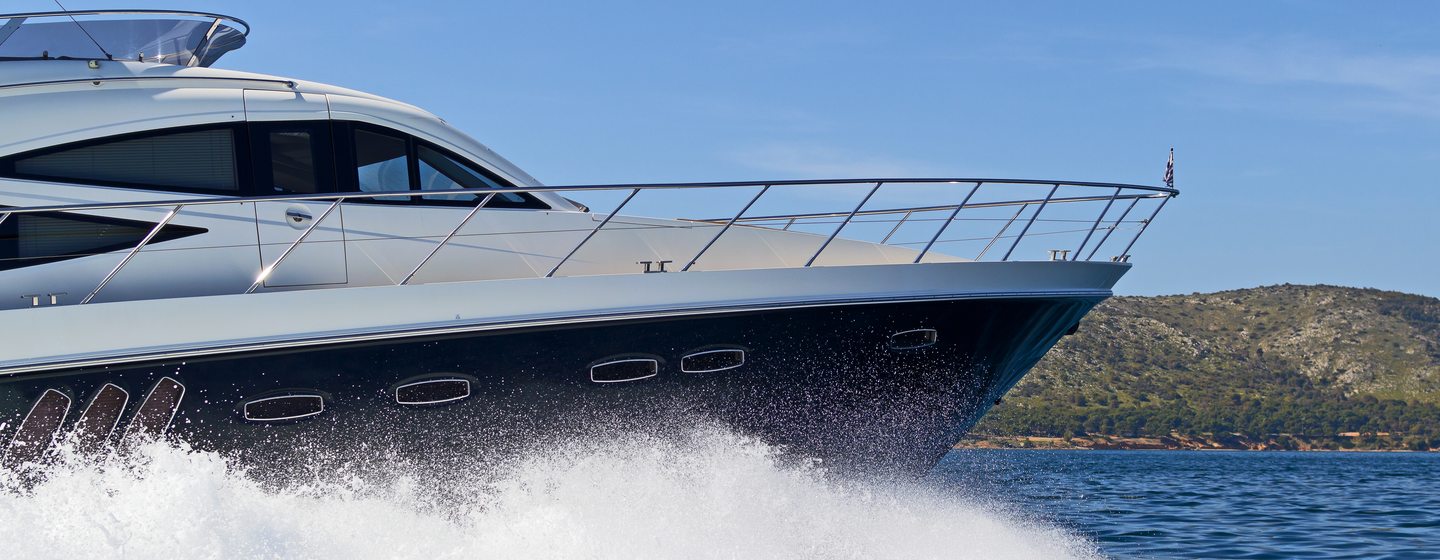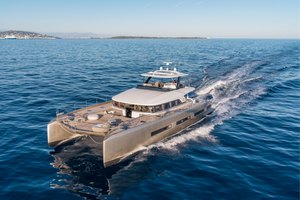How to choose the right hull type for your style of yachting? Fast and exhilarating? Slow and steady? Or is efficiency your priority? Whatever performance you want from your yacht, there's a hull type to suit.
There is quite a selection of alternative hull designs, and with a growing emphasis on fuel efficiency, environmental impact, and range, the variety is increasing. We take a look at yacht hull design and advise on what to consider for your next yacht purchase.
- The Dawn of Speed
- How a Planing Hull Works
- What is a Vee Hull Design?
- Vee and Deep Vee Hulls
- Medium Vee Hull
- How do Modified Vee Hulls work?
- The Versatility of Semi-Displacement
- Displacement Hulls Explained
- Displacement Hull: Round Bilge
- Chine: Hard or Going Soft?
- Displacement and Hull Speed Explained
- Hull Speed Considered
- Fast Displacement Hulls
- Multihulls: Are Two Better than One?
- Trihedral (Cathedral) Hulls
- Frequently Asked Questions (FAQ)
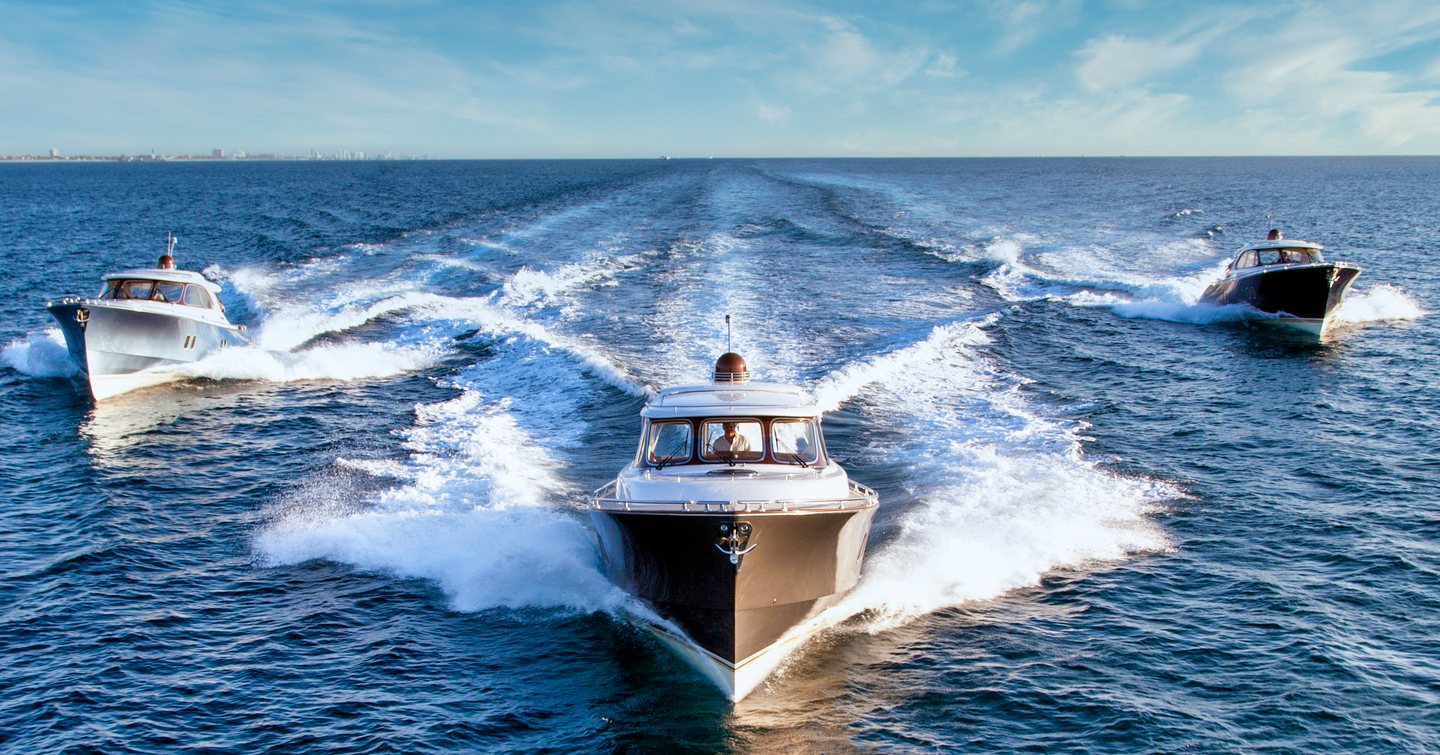
Streamlined objects, whether it's an airplane fuselage or a knife, tend to excel in performance, regardless of their application. In the realm of yacht design, a sharp, narrow, and slender hull proves to be more efficient at navigating through water compared to a bulkier, boxier design.
Boxes, however, excel at efficient space utilisation: a wider, fuller hull is ideal for comfortable accommodation, spacious saloons and suites. This encapsulates the enduring challenge yacht designers have grappled with for decades.
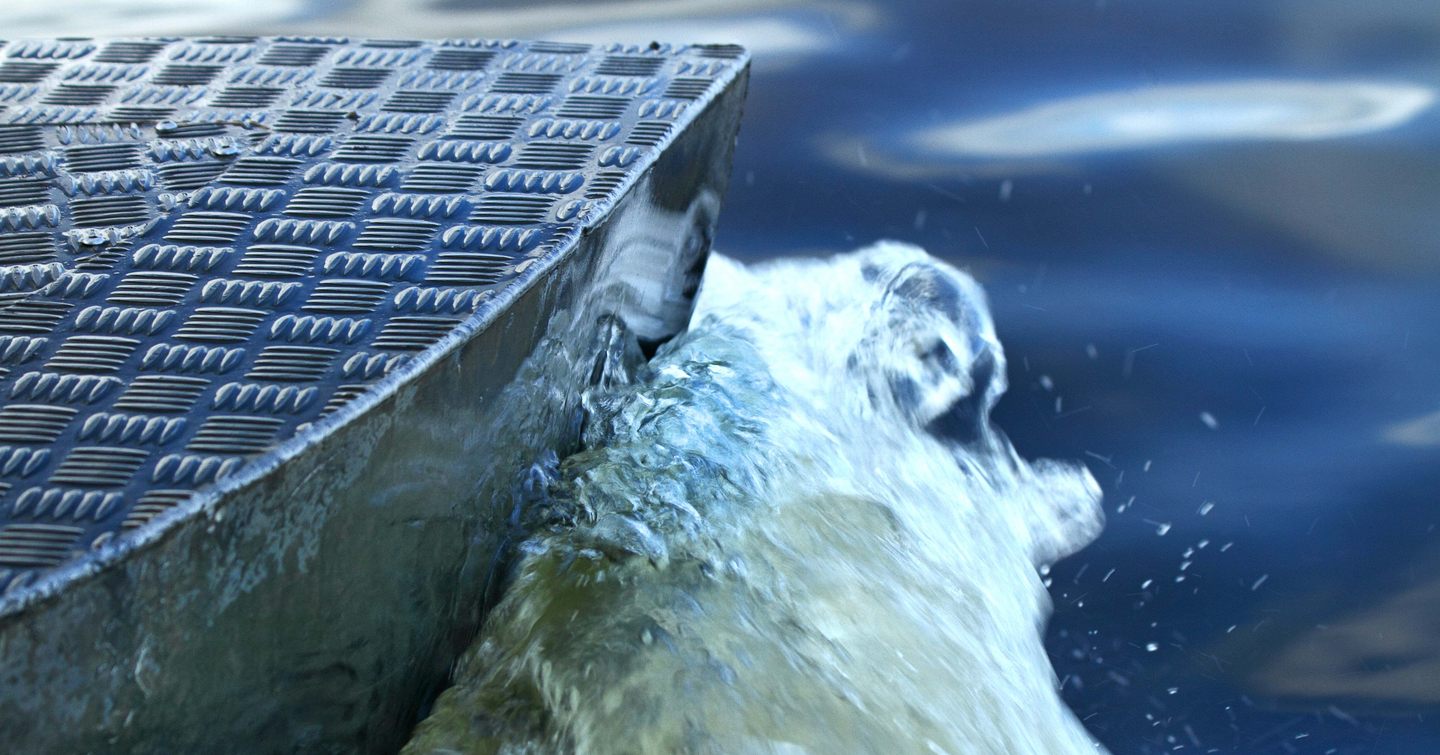
The Dawn of Speed
Displacement yachts are designed primarily for smooth water navigation, pushing through the water, so a long, narrow configuration is the ideal for achieving optimal and efficient performance. A longer displacement hull will hold the promise of greater yacht speed, however, an elongated design will compromise cabin size.
If yacht speed is the less important factor, then choosing a slightly wider, fuller hull type will gain some extra internal space, losing only a little in cruising speed.
If you do have a need for speed, the space vs speed compromise is through the planing hull design. A planing hull is characterised by a flatter and wider hull shape that allows the yacht to rise up and skim over the water's surface at high speeds.
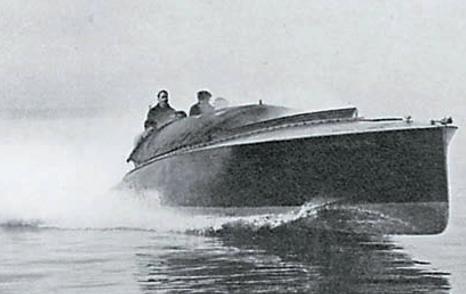

Planing hulls were introduced in the early twentieth century, an innovation that revolutionised yacht culture by offering the thrill of high-speed cruising. A far cry from the luxurious planing yachts we have today, the early designs featured flat-bottoms that allowed for high-speed skimming across the water. They were responsive and fast, but incredibly uncomfortable.
The evolution of planing hulls progressed with the introduction of the deep vee hull design. This design features a sharp entry, or ‘deadrise’ at the bow, that allows the yacht to cut through waves and provides a faster, smoother ride. However, significant horsepower is required to generate the necessary lift.
As the deadrise became deeper, even more power was needed to get the yacht onto the plane. This high power requirement, especially for larger and heavier cruising yachts, made it costly and less efficient in terms of fuel consumption and overall operation.
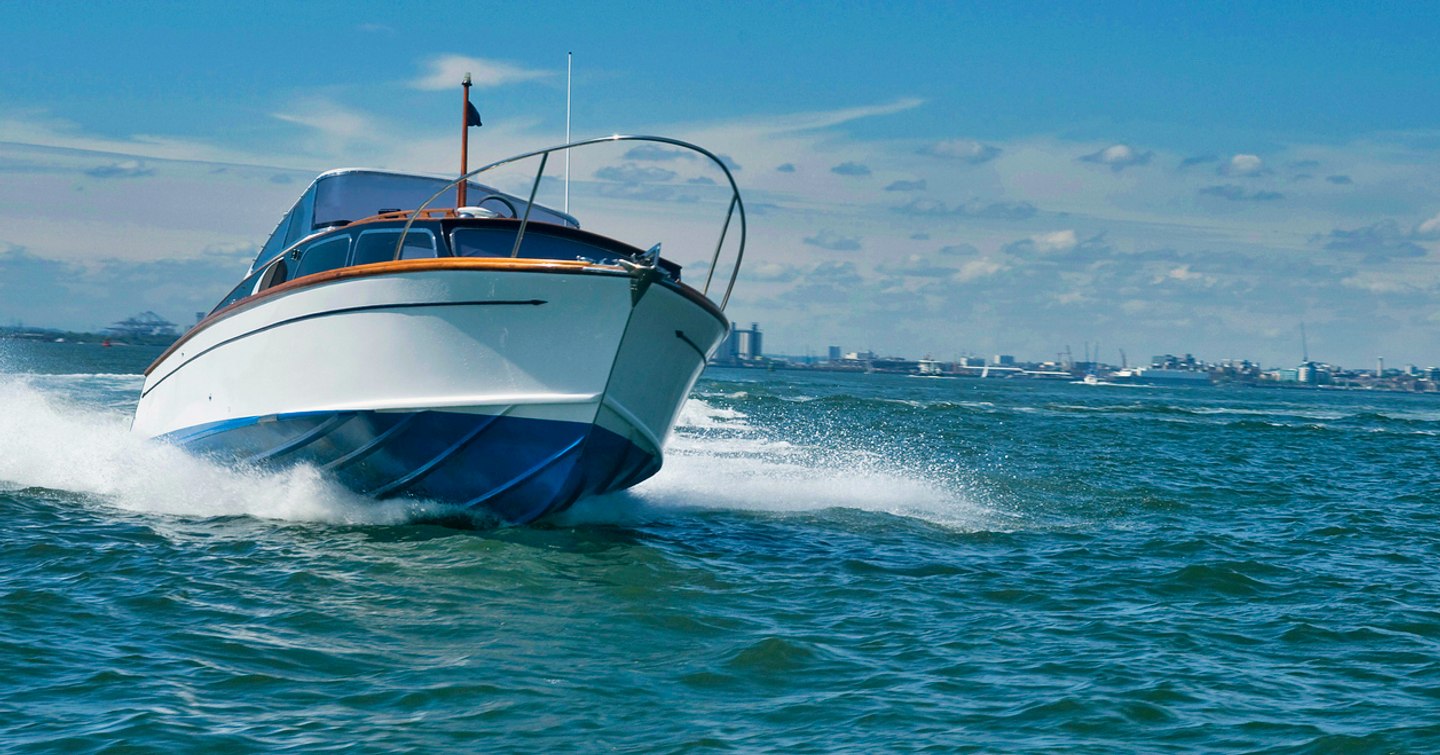
Additionally, deeper vee hull designs are, by their nature, quite narrow. So we are back at square one, with smaller interiors spaces, only this time from faster, more expensive yachts.
The real eureka moment came not in a revolutionary moment but over decades of evolving hull design, calculating where the deeper vee sections had to be to deliver a smooth ride, and where they could flatten out to create both efficient lift and interior volume.
The modified vee hull design serves as the foundation for the majority of fast-cruising yachts in use today. High-quality examples of this hull design offer a nimble, well-controlled, and smooth ride, efficiently transitioning the yacht onto the plane.
It’s also important to acknowledge the semi-displacement hull design for its significant, albeit less glamorous, contribution to yacht owner hull choice.
This design, as the name implies, combines elements of both displacement and planing hull types, retaining the key features like the rounded sections and keel for stability while incorporating planing sections.
How a Planing Hull Works
A planing yacht hull works by using the lift generated by its high-speed forward motion to rise up and skim across the water's surface.
To initiate planing, the boat needs to reach a critical speed known as the "planing speed." This speed varies depending on the boat's size, weight, and hull design. Once the planing speed is achieved, the boat starts to lift out of the water.
As the yacht rises onto the plane, it reduces the amount of hull that's in contact with the water. This results in a significant reduction in water resistance, allowing the boat to reach higher speeds with less effort.
Search for yachts for sale using a planing hull design.
What is a Vee Hull Design?
A vee hull is a boat hull design with a V-shaped bottom that provides stability, efficient wave handling, and comfort in various water conditions. It can be designed for displacement or planing, depending on its intended use and engine power. The angle of vee is called the deadrise: the flatter or lower angle of the vee, the more lift can be created. The deeper or higher the angle of the vee, the more controllable and smooth the ride is at speed.
The V-shaped bottom comes to a point at the bow, so when the boat encounters waves or rough seas, the vee hull is designed to slice through the waves, rather than riding over them like a planing hull.
Generally more fuel-efficient than planing hulls at lower speeds, this yacht hull type is ideal for cruising, fishing, and other activities that involve moderate speeds and stability.
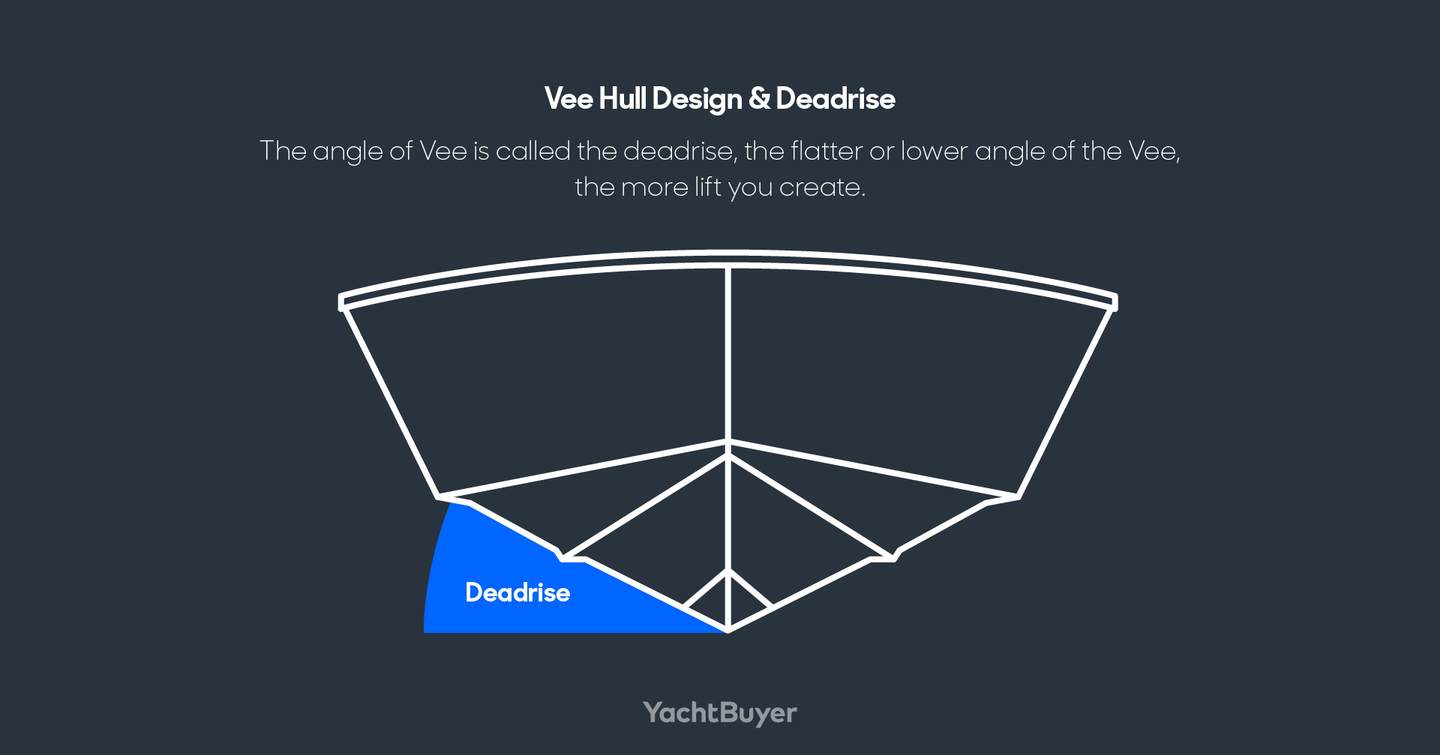
Vee and Deep Vee Hulls
A deep vee hull is a specific type of vee hull design characterised by a sharp and pronounced V-shaped bottom typically with a deadrise angle (the angle between the horizontal line and the V) of 20 degrees or more. The hull extends deep into the water, and allows the yacht to cut through waves and rough water with greater ease.
Deep vee hulls are versatile and used for offshore fishing boats, high-performance powerboats, and some larger recreational cruisers due to their ability to handle various sea conditions.
Yacht owners choose deep vee hulls for their vessels for their balance of comfort, seaworthiness, speed, stability and suitability for offshore navigation. A deep vee hull yacht will often maintain good resale value due to their reputation for seaworthiness and performance.
Pros
- High speed
- Comfortable ride
- Good grip and directional stability
- High resale value
- Stability
- Efficiency
Cons
- Fuel consumption
- Deeper draft can be restrictive
- Higher initial cost
- Noisy at higher speed
- Comfort in calm seas
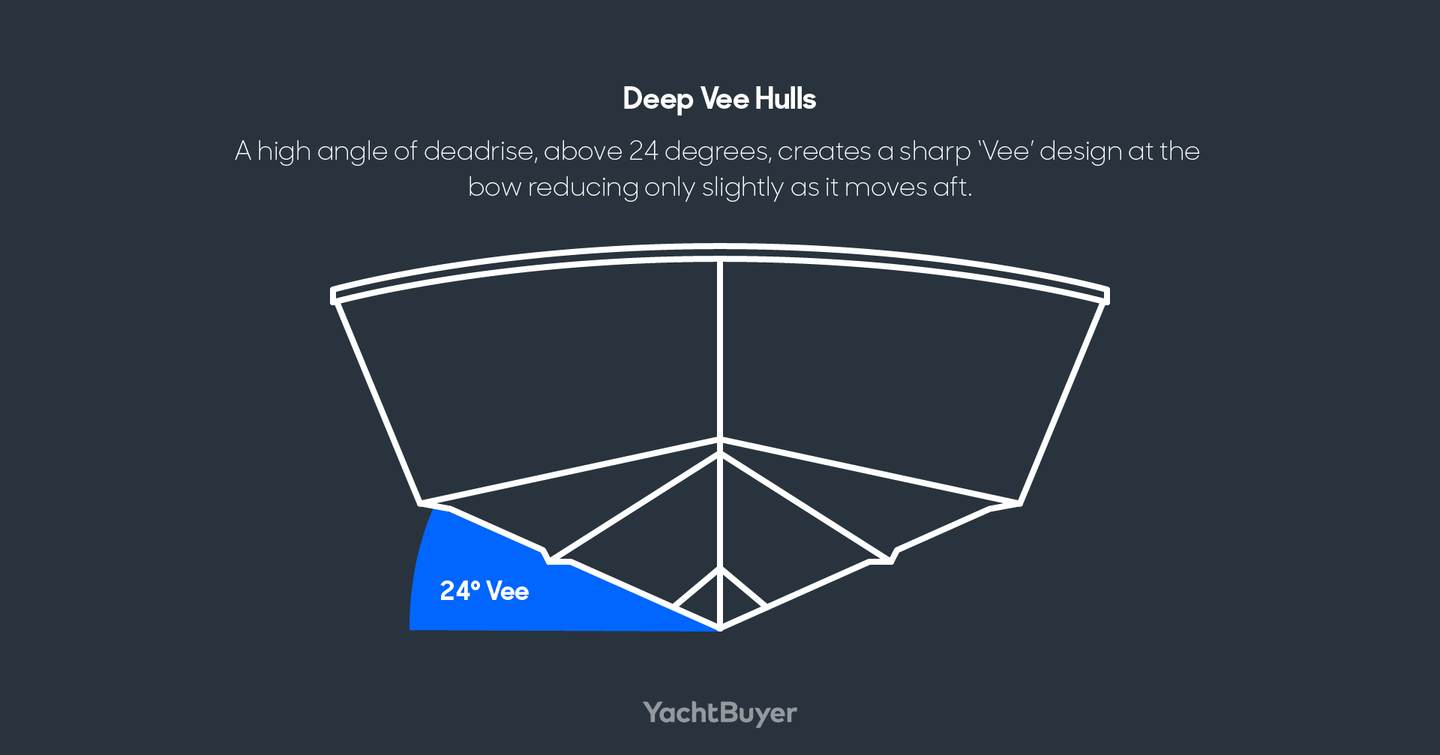
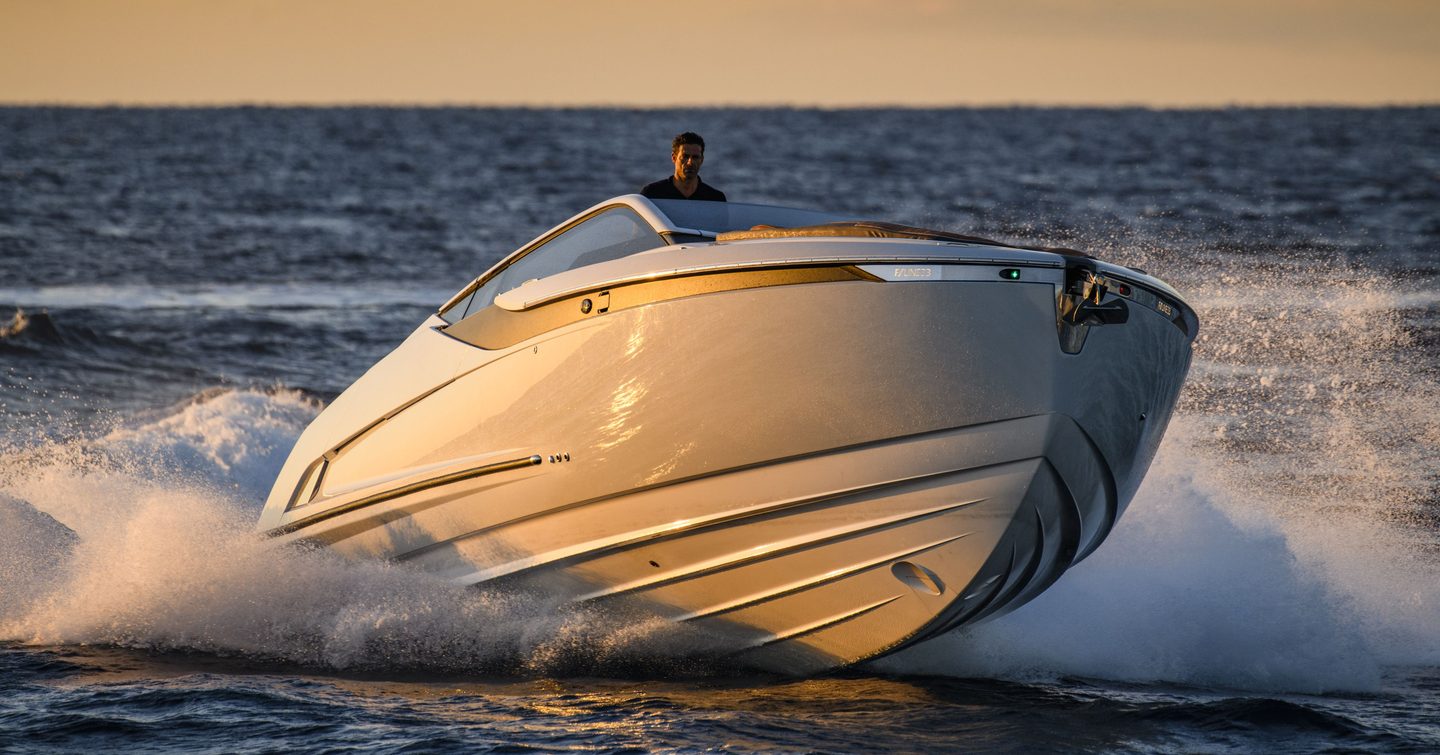
Medium Vee Hull
A yacht hull design that falls between a flat-bottomed hull (shallow vee) and a deep vee hull in terms of its V-shape angle or deadrise. There isn't a precise standard for what constitutes a "medium" vee, although typically it refers to a deadrise angle ranging from approximately 15 to 20 degrees.
This hull design strikes a balance between stability and wave-handling capability, and id therefore found in a wide range of boat types, including runabouts and smaller fishing boats. Their design allows them to perform well in various conditions, from relatively calm waters to moderately rough seas.
A medium vee yacht hull can achieve a fairly good balance between speed and fuel efficiency.
Pros
- Efficient cruising performance
- Speed and comfort
- Greater beam and internal volume
- Effective wave handling
Cons
- Harsh ride in choppy seas
- Less directional
- Stability when stationary
- Finding the speed and efficiency balance
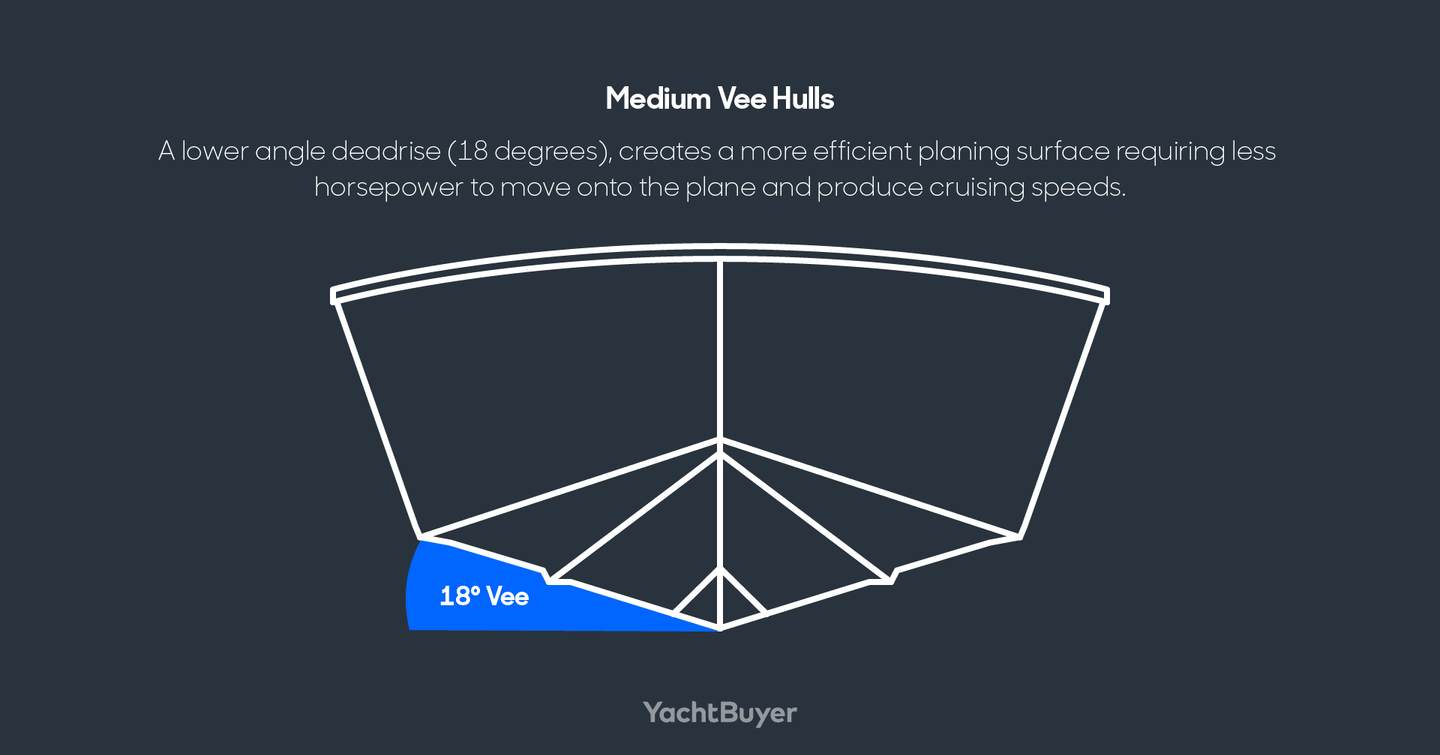
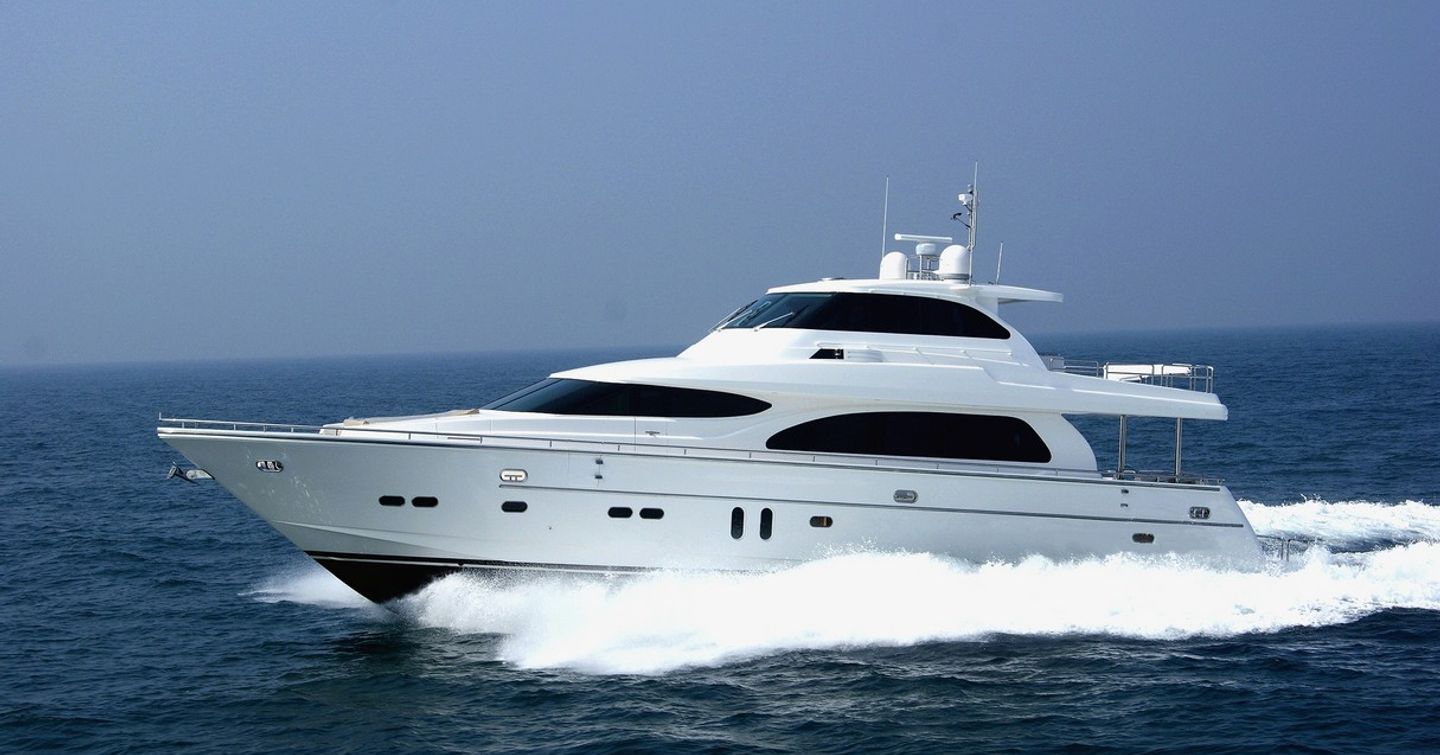
How do Modified Vee Hulls work?
Combining the elements of both flat-bottomed hulls and vee hulls, a modified vee hull is characterised by a hull bottom with a less pronounced V-shape, typically featuring a deadrise angle (the angle between the horizontal line and the V) of around 5 to 15 degrees.
A modified vee hull offers better stability at rest compared to deep vee hulls, making them suitable for activities like fishing where stationary stability is important; although not as effective at cutting through waves, they do provide a reasonably comfortable ride in moderately choppy conditions.
A modified vee hull offers a versatile and balanced option for recreational boaters, with greater volume required for more spacious interiors.
Pros
- Good internal volume
- Efficient cruising
- Comfortable cruising
- Stability at rest
Cons
- When done right very few
- Avoid extreme sea conditions
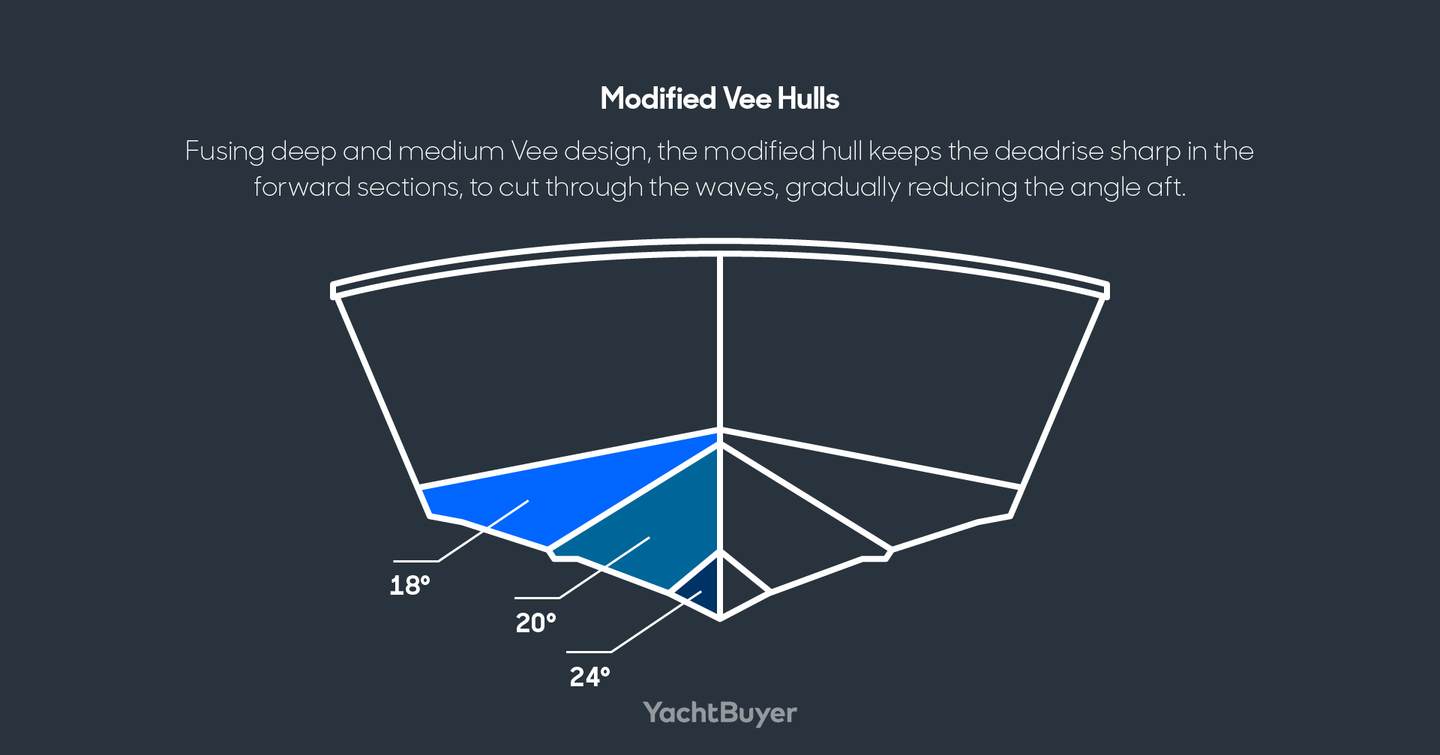
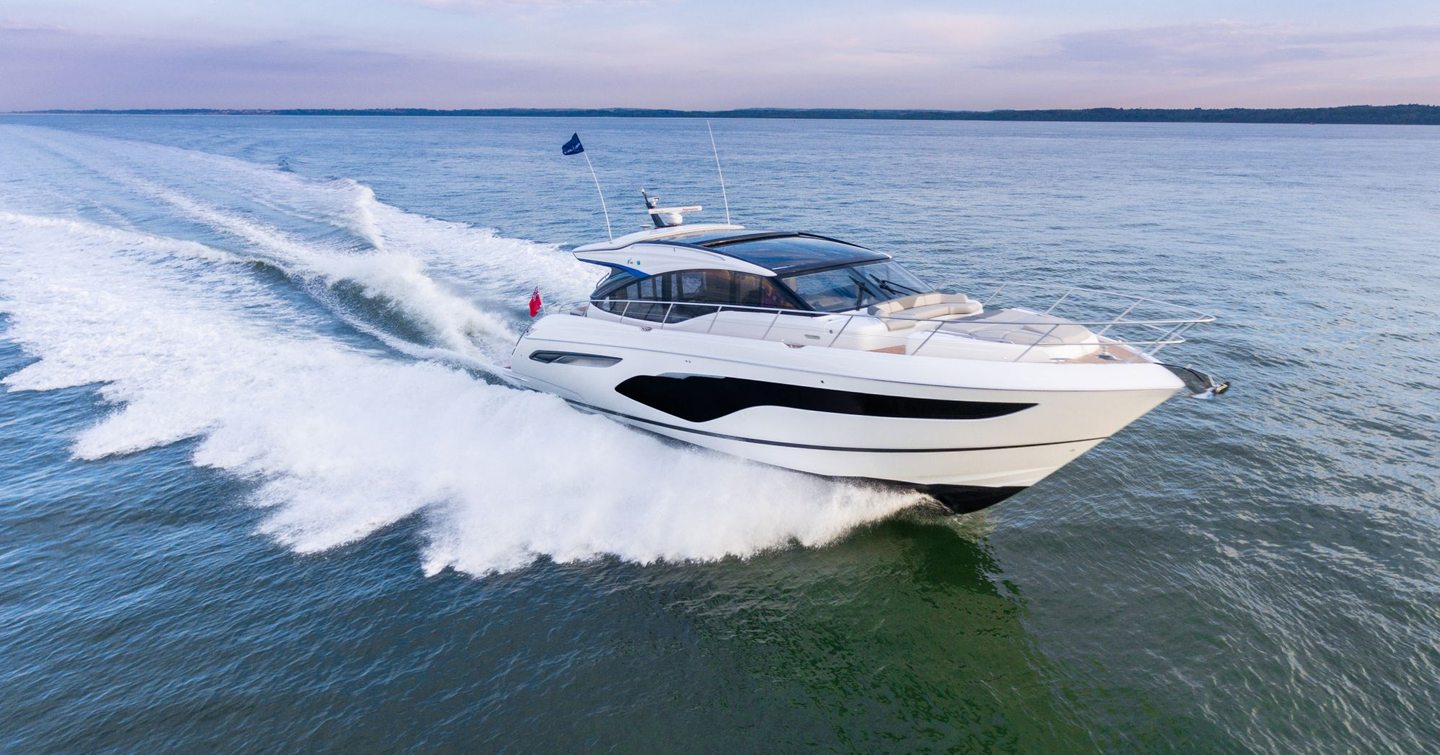
The Versatility of Semi-Displacement
The best of both worlds? Unlike planing hulls, that aim for high-speed performance, or full displacement hulls that prioritise stability and efficiency, the semi-displacement hull strikes at the middle ground, and has delivered some of the best cruising yachts ever built.
The key feature of a semi-displacement hull is its ability to transition between displacement and planing modes. At lower speeds, it will function as a displacement hull, efficiently cutting through the water with minimal resistance, with fuel efficiency and a comfortable ride as given. Increase the power and the yacht will rise up onto the water's surface, achieving higher speeds, and an exhilarating cruising experience.
Semi-displacement yachts are popular for those who appreciate the ability to explore at a leisurely pace, with the option to pick up the pace when required. This design allows for extended voyages, fuel efficiency, and a comfortable onboard experience, making it a versatile choice for many yacht owners.
Search for yachts for sale using a semi-displacement hull design.
Semi Displacement Features
- Beam and fuller hull sections for good interior volume
- Deep, slender entry to cut through waves
- Planing sections for lift
- Keel for stability
- Round bilge (sometimes harder chine at the waterline)
- Versatile
Semi-displacement yachts are celebrated for their excellent seafaring qualities. The deep entry at the bow effectively eliminates slamming, as the yacht slices through the waves, and the keel enhances stability and water grip.
The hull sections typically have a round bilge, characterised by a smooth and rounded form that extends to the waterline. Some designs may incorporate additional smaller bilge keels on each side to further enhance stability and assist during beaching fpr drying out.
As an alternative, some semi-displacement designs opt for a squarer hull shape, with a hard chine or edge at the waterline. This hull design generates more lift and aids the yacht on to the plane. The yacht will excel in ride quality, especially in the 15 to 20 knots speed range.
The keeled hull design enables comfortable cruising at slower displacement speeds, ensuring a stable and enjoyable experience for those who prefer a more leisurely pace.
Pros
- Versatility
- Efficiency
- Stability
- Wave handling
- Comfort
- Interior space
- Manoeuvrability
Cons
- Limited in extreme conditions
- Lower top speeds
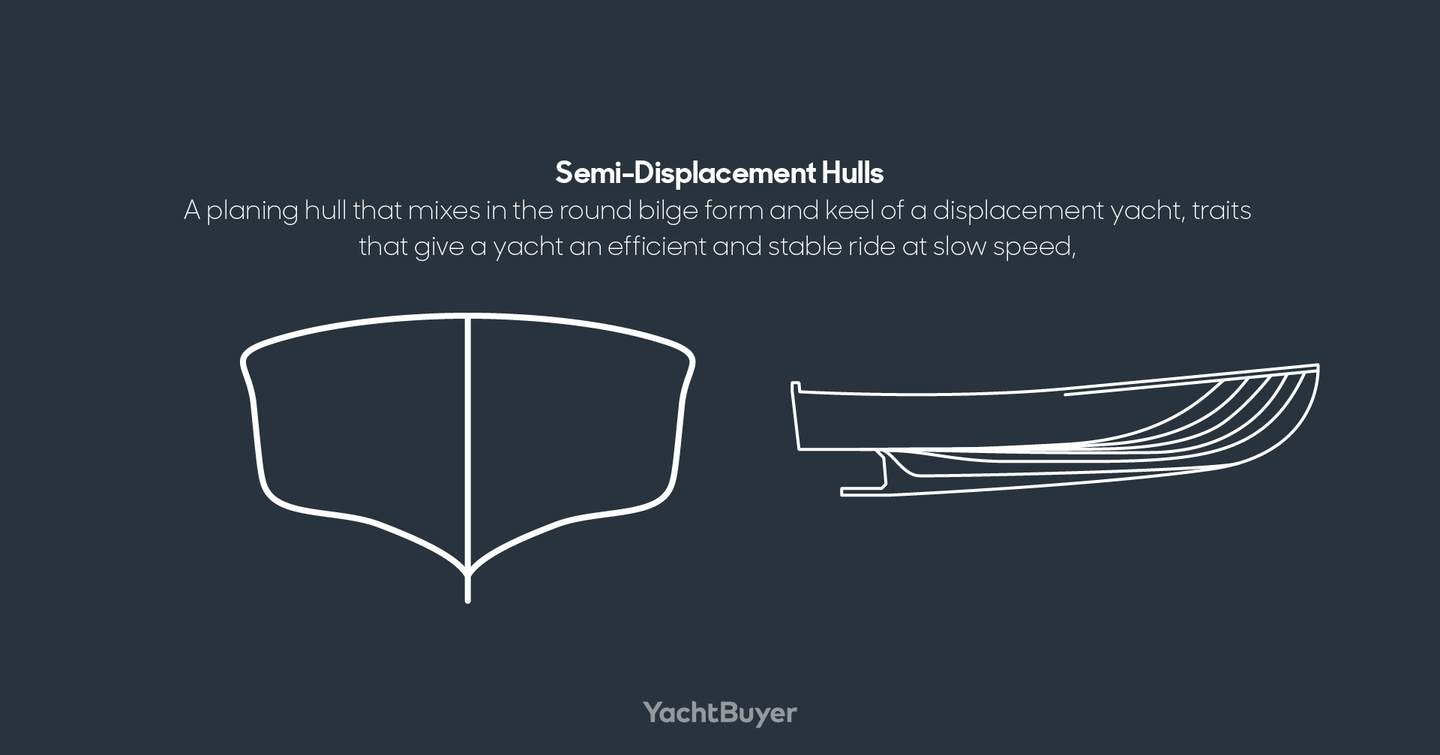
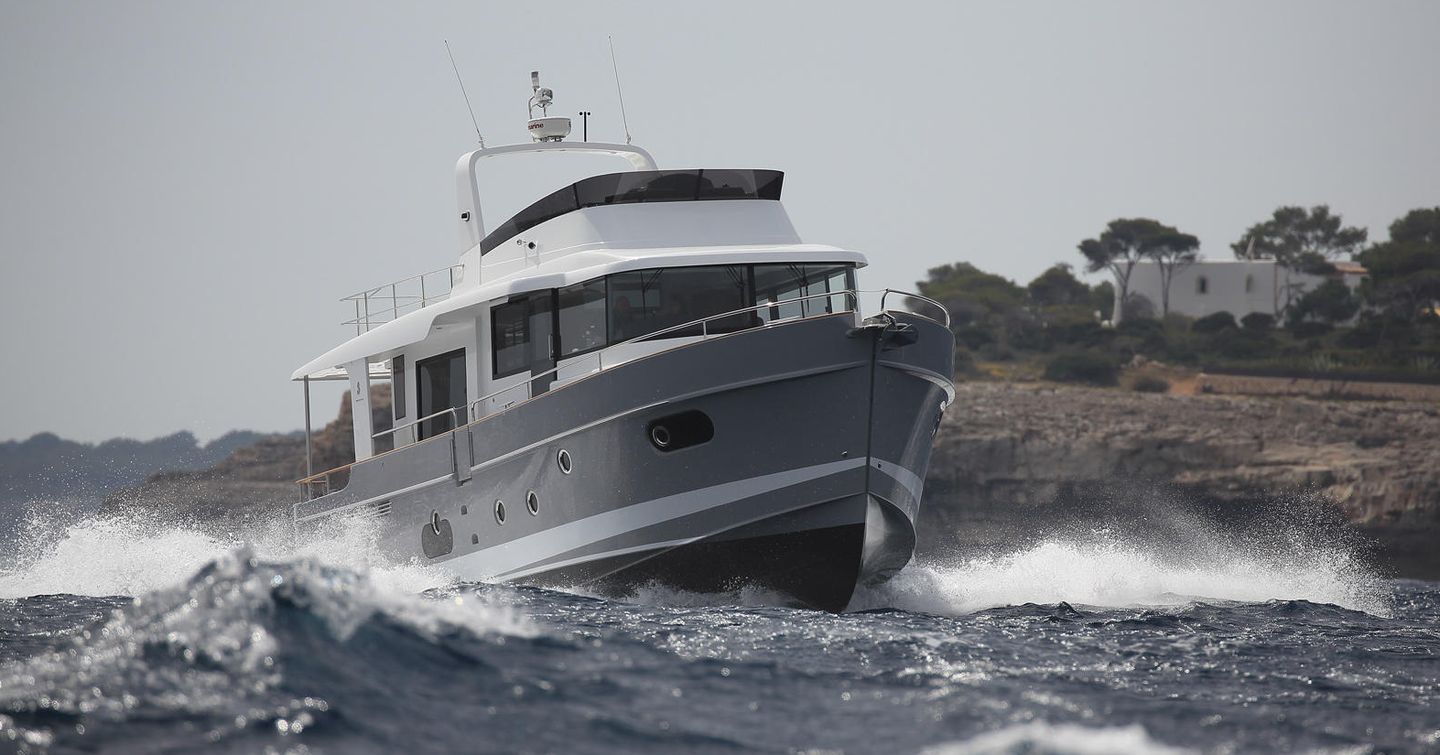
Displacement Hulls Explained
A displacement hull, often referred to as a full displacement hull, is designed primarily for slow and efficient cruising through the water. The primary principle behind this yacht hull design is to displace, or move aside, the water as the yacht moves forward, rather than trying to rise up onto the water's surface, as planing hulls do.
Whilst moving slowly through the water can lead to the hull being pushed around by the waves, the keel aids grip in the water thus providing a more level and controllable ride. Increasingly, yachts are fitting stabilisers to further add to stability and comfort.
Displacement hulls are designed for efficient and fuel-conservative cruising at relatively low speeds, and are known for their excellent fuel economy. Due to their wide beam and efficient use of space, displacement hulls provide spacious and comfortable interiors with ample headroom and accommodation.
Search for yachts for sale using a displacement hull design.
Pros
- Fuel efficiency
- Comfort
- Stability
- Interior space
- Safety
Cons
- Restricted speed
- Rolling motion if not stabilised
- Initial cost
- Handling at low speeds

A displacement yacht’s speed is limited to its length and beam: a longer and narrower hull will have a faster displacement speed than a shorter fuller design.
Displacement Hull: Round Bilge
Characterised by its smoothly rounded shape below the waterline, the term "round bilge" refers to the hull's cross-sectional shape. This form of displacement hull design minimises water resistance, resulting in superb fuel economy and long range cruising.
With exceptional stability, both at rest and when underway, the smooth and stable ride of a round bilge displacement hull enhances passenger comfort, reduces motion sickness and creates a very pleasant experience onboard, with spacious interiors and comfortable accommodation, ideal for extended voyages.
As with all displacement hulls, this is not the hull design a yacht buyer would choose if seeking peak performance. Attempting to exceed the displacement speed requires impractical increases in power.

Chine: Hard or Going Soft?
A chine refers to a distinct edge or angle on the hull where the bottom of the hull meets the sides (or topsides). The presence or absence of chines can significantly influence a boat's performance, handling, stability, and overall design characteristics.
Yachts with hard chines have a clear, well-defined transition between the two surfaces, and are often associated with planing hull designs, where the chine plays a role in providing lift and stability as the boat rises onto the plane.
Whereas a soft chine features a more gradual, rounded transition between the bottom of the hull and the sides, resulting in a smoother and less angular appearance along the hull's edges.
When a yacht buyer decides between a hard chine and a soft chine there will be a significant impact on the yacht’s performance.
A buyer choosing a yacht with hard chines is looking for a yacht that will plane more easily and may achieve higher speeds, with a more stable ride in planing conditions.
Whereas choosing a yacht hull with soft chines is to seek a comfortable and stable ride when the yacht is in displacement or semi-displacement mode.
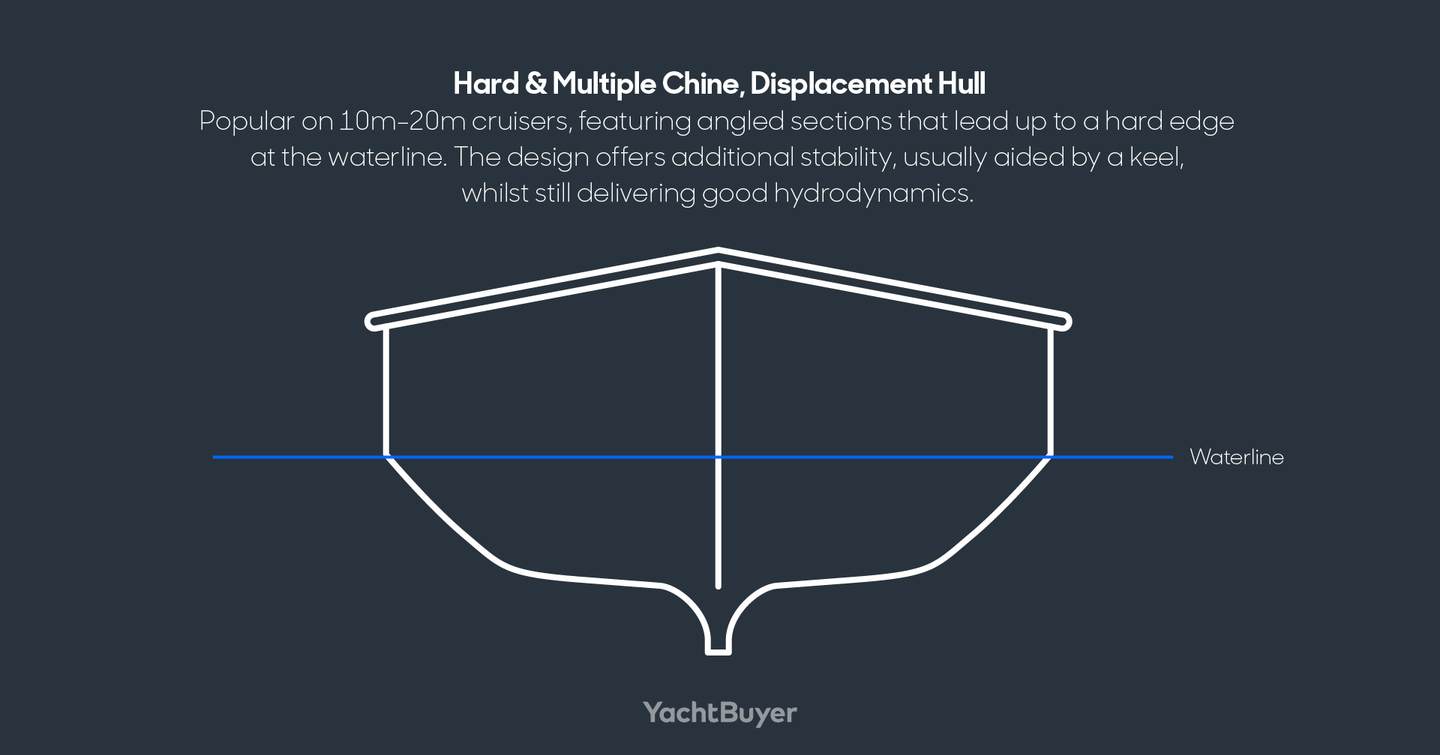
Displacement and Hull Speed Explained
Essentially the same thing, displacement speed is often referred to as hull speed and refers to the maximum speed at which a displacement hull can move efficiently through the water. This is a fundamental concept in yacht design and is determined by the waterline length, (the length of the hull that is in direct contact with the water when the boat is at rest).
Hull Speed Considered
A yacht owner should consider hull speed as it directly impacts the boat's performance, efficiency, comfort, and overall boating experience.
- Operating a yacht near its hull speed is the most fuel-efficient way to cruise.
- Staying near hull speed allows yacht owners to cover longer distances on a single tank of fuel.
- Cruising at or near hull speed provides a comfortable and stable ride for everyone onboard.
- Staying close to hull speed allows the yacht to cut through waves rather than riding over them, resulting in a smoother and more stable ride.
Maintaining an efficient speed is essential for safe navigation. Cruising comfortably at a consistent speed helps ensure safe and predictable boating.
For yacht owners who consider environmental sustainability, cruising at, or near, hull speed lowers fuel consumption, therefore reducing the yacht's carbon footprint and minimizing its impact on the marine environment.
Displacement Hull Performance Table
| Hull Length | Speed |
|---|---|
| 10m | 7.6 knots |
| 15m | 9.4 knots |
| 20m | 10.8 knots |
| 30m | 13.2 knots |
| 50m | 17.1 knots |
| 100m | 24.2 knots |
*All speeds are approximate and will vary from manufacturer to manufacturer
Fast Displacement Hulls
By increasing the lift, this innovative hull design combines the efficiency and seakeeping qualities of a displacement hull, with the potential for higher speeds associated with a planing hull. This hybrid hull design offers a versatile and efficient platform for yachts to perform well both at displacement speeds and whilst planing.
Essentially a hybrid between a displacement hull and a planing hull, a fast displacement hull will be efficient at slower cruising speeds resulting in good fuel economy and maintains stability, both at displacement speed and whilst planing. The hull design is adaptable to a range of boating activities: they offer good manoeuvrability and responsiveness, making them easy to handle when docking and close quarter boat handling.
A yacht with a fast displacement hull represents versatility for those who want the best of both worlds. It offers an excellent compromise between fuel efficiency, stability, comfort, and the potential for higher speeds, catering to a wide range of boating preferences and activities.
Search for yachts for sale using a fast displacement hull design.
Pros
- Versatility
- Efficient cruising
- Stability
- Handling in adverse sea conditions
- Speed capability
- Responsive
Cons
- Draft may be restrictive
- Likely to require customisation
- Cost
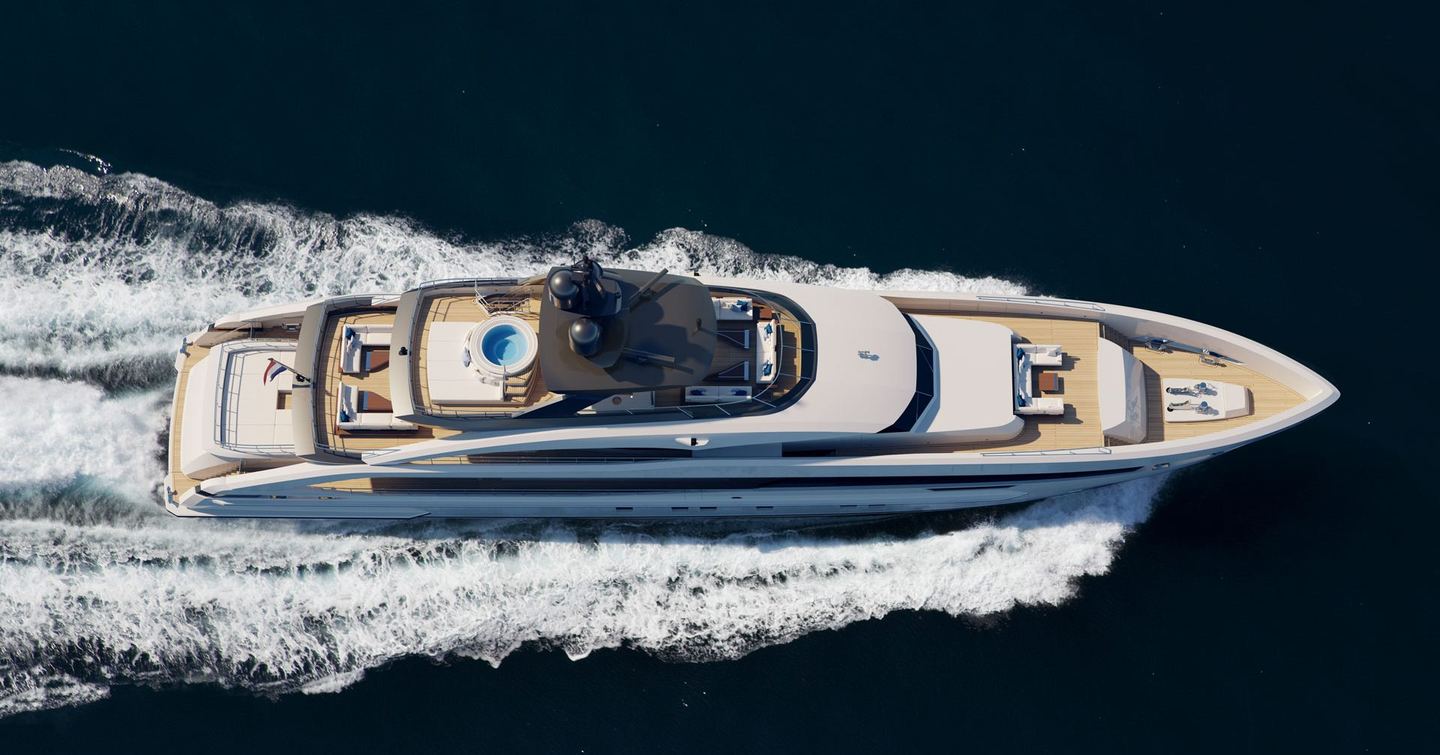
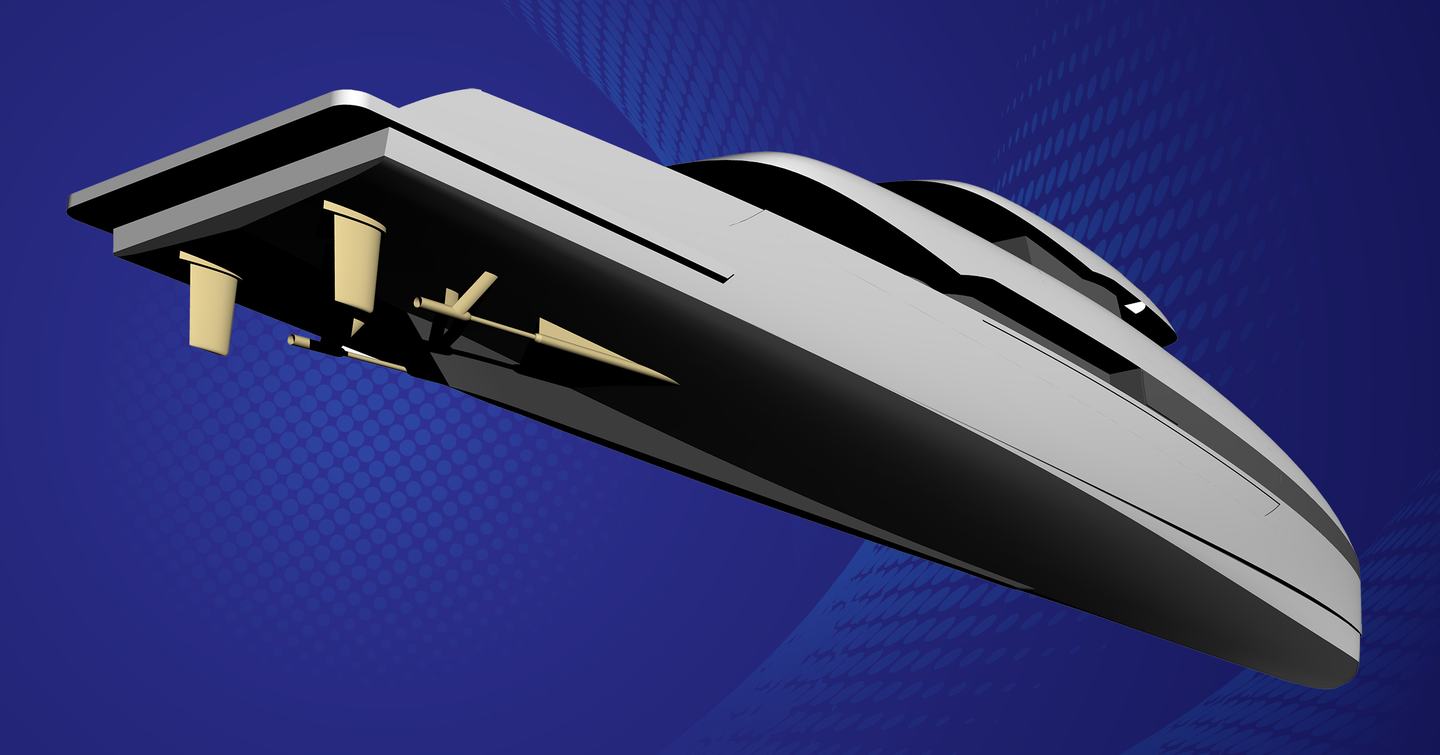
Speed and Superior Performance
When exploring the realms of speed and performance, it's interesting to look at the innovative designs of hydrofoil hulls and high-performance hulls. In recognition of their distinctiveness and the keen interest surrounding their hull designs, we have crafted separate articles dedicated to each.
Multihulls: Are Two Better than One?
A monohull (mono, as a prefix, meaning ‘one’ or ‘only’) is a single hull, whereas a ‘multi’ hull is a vessel featuring multiple hulls: typically two, a catamaran or even three, a trimaran.
Multihulls boast a distinctive design, gaining popularity for their exceptional stability. Their wider hull stance offers a solid base, minimizing the risk of capsizing and ensuring stability even in challenging sea conditions. This heightened stability enhances passenger comfort, making multihulls a sought-after choice for family cruising and charter vacations, especially for those susceptible to motion sickness.
Catamarans are fast and efficient. Their reduced surface area and lightweight construction encourage higher speeds with less resistance.
For interior space, a ‘cat’ is hard to beat, with spacious cabins and entertainment areas, allowing for luxurious accommodation and amenities. Storage is a bonus too, with large fuel and water tanks ideal for long-distance cruising.
Pros
- Lateral stability
- Efficient performance
- Range of hull types
- Interior space and storage
- Reduced draft
- Comfort
Cons
- Initial cost
- Maintenance
- Berthing fees
- Resale - smaller buyer pool
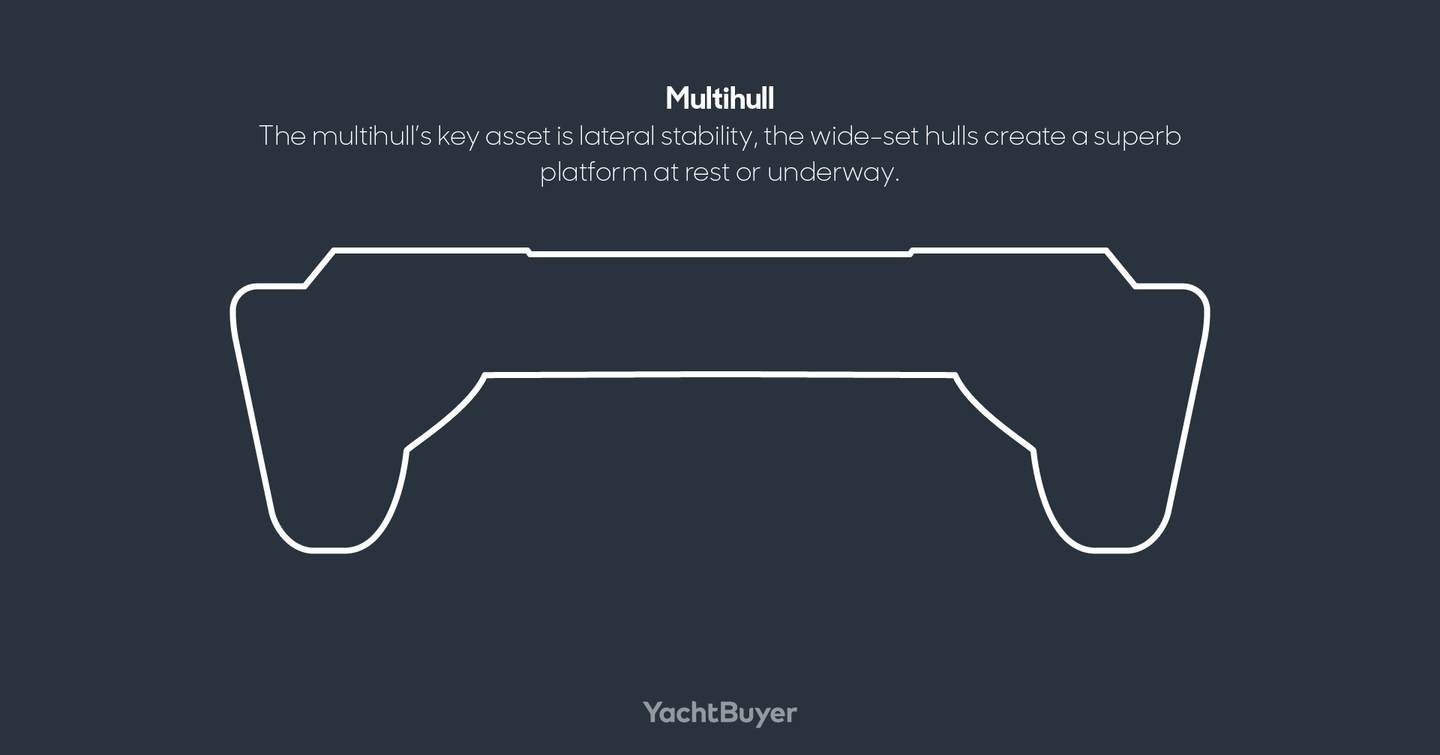


Trihedral (Cathedral) Hulls
A trihedral, or cathedral, hull is often misunderstood as a multihull, but it's actually a single-flowing hull form. It features three distinct surfaces or faces meeting at sharp angles, forming a three-sided shape. These hulls prioritize efficiency, making them ideal for high-speed cruising and racing motor yachts.
The primary advantage of a trihedral motor yacht lies in its potential for exceptional speed and performance. While less common in the broader motor yacht market, where comfort and luxury are the usual focus, trihedral yachts find their niche in competitive motor yacht racing events where speed and performance are paramount.
These yachts cater to a specific audience of enthusiasts who seek thrilling on-water experiences and participate in competitive racing events.
Pros
- Custom built for specific need
- High performance
- Thrilling ride
Cons
- Uncomfortable
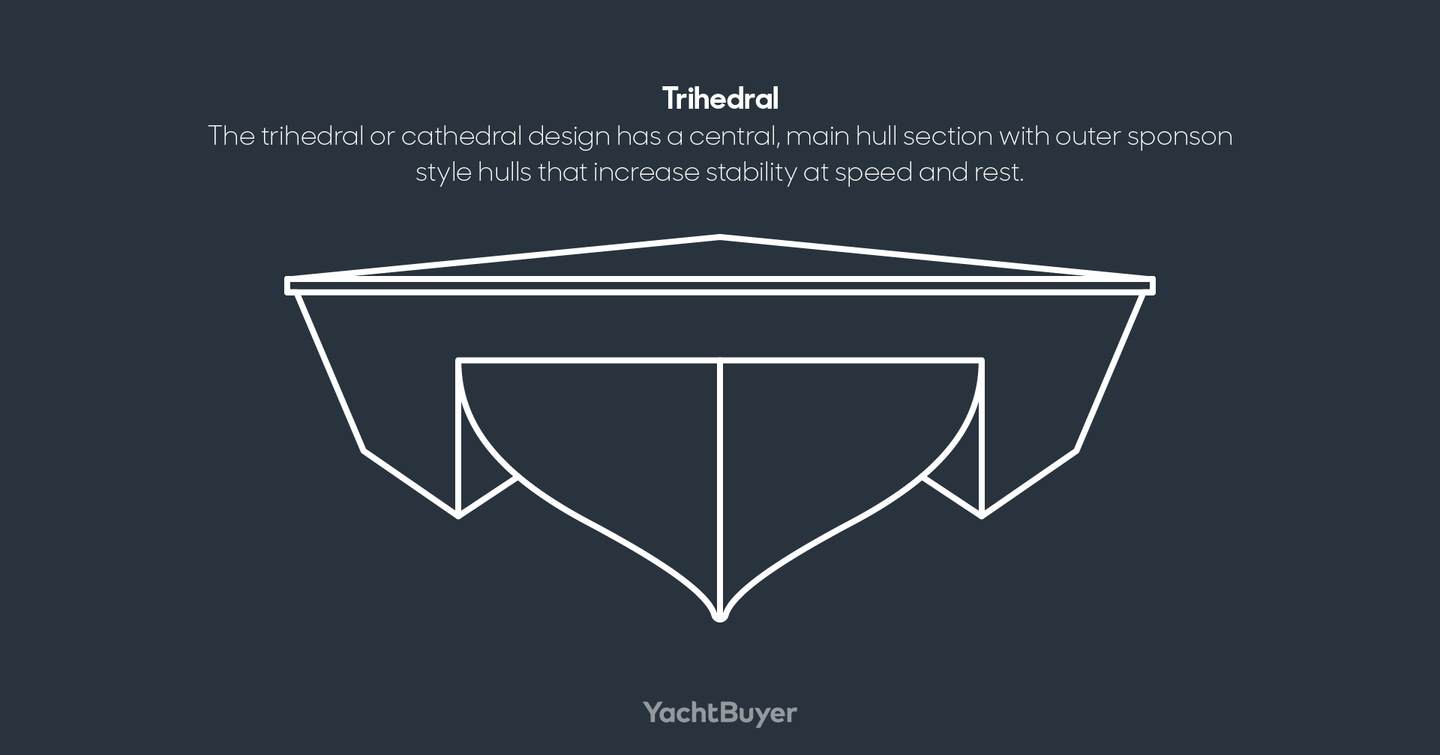
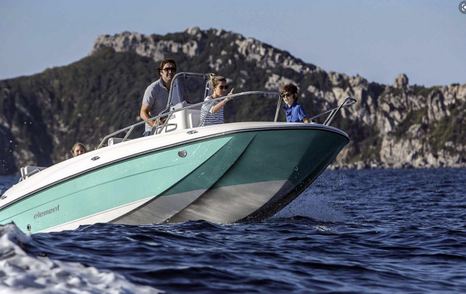
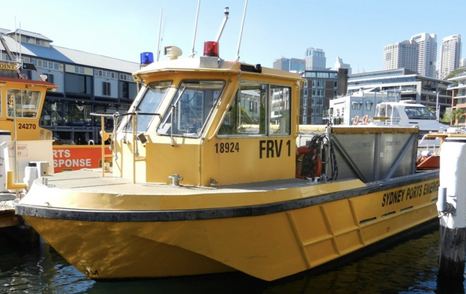
Frequently Asked Questions (FAQ)
What Yacht Hull Design is Best for Stability?
Multihulls are renowned for their exceptional stability, with several contributory factors:
- The wider beam: The wide beam of a multihull creates a broad and stable platform on the water, reducing the risk of capsizing or heeling (leaning) excessively, even in strong winds.
- Sharing the load: The two hulls spread the yacht's weight over a larger surface area; this lowers the centre of gravity, and minimises rolling motion.
- Reducing the ballast: A multihull requires less ballast because their wider design and multiple hulls naturally provide stability without the need for excessive weight.
- Handling the waves: Their wide beam and multiple hulls cut through waves rather than riding over the top, resulting in a smoother and more stable ride.
- Reduce the rolling: The combination of a wider beam and the separation of hulls reduces rolling, making them more comfortable for passengers and reducing the risk of seasickness.

What Yacht Hull Design is Best for Spacious Accommodation?
The wide beam of catamarans (multihull) provides generous living space and privacy for guests, and are well known for their expansive cabin accommodation.
The monohull's singular volume creates excellent below deck accommodation, with more modern designs also creating extra width and height. If cabin space is your priority, a planing hull, be that a Vee or semi-displacement design, is hard to beat.
Semi-displacement yachts focus on a balance between performance and accommodations, with comfortable cabins easily placed in the design mix.
With the fast displacement yachts, the focus is on performance and style rather than maximizing the comfort of the cabins.
On balance, the monohull probably delivers the best overall mix of deck and interior space and design.
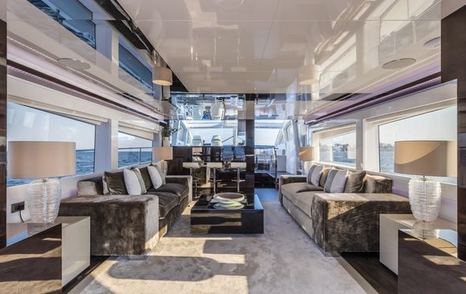
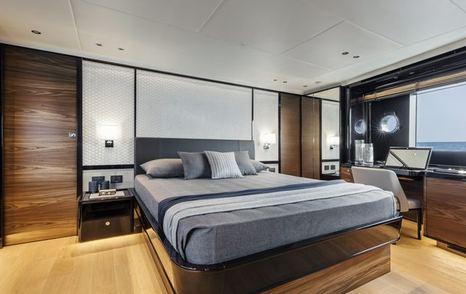
Monohull vs Multihull Beam Comparison Chart
| Yacht LOA | Mono Hull | Multihull | % increase |
|---|---|---|---|
| 10m | 3.5m | 4.5m | +35% |
| 12m | 4m | 6.5m | +45% |
| 15m | 4.5m | 6.5m | +45% |
| 20m | 5m | 10m | +100% |
| 30m | 7m | 14m | +100% |
N.B. The 'beam' of a yacht is its width at its widest point
What Yacht Hull Design is Best for a Beginner?
A semi-displacement yacht provides a stable and predictable platform for motor yacht beginners.
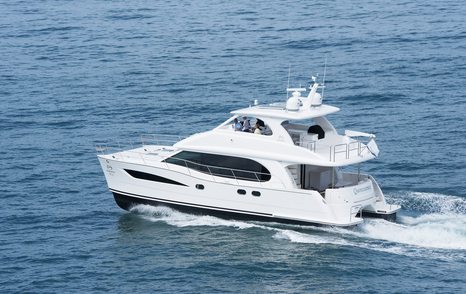

Semi-displacement yachts are versatile and well-suited for various boating activities, including cruising, day trips, and fishing.
Semi-displacement yachts are easy to handle.
Semi-displacement hulls can provide a comfortable and smooth ride, even in moderate sea conditions.
Many semi-displacement yachts can transition to semi-planing speeds. This feature allows beginners to experience higher speeds when safe to do so while having the option for more efficient cruising at lower speeds.
It is no coincidence that training centres operate semi-displacement yachts.
What Yacht Hull Design is Best for Speed?
The planing hull design is synonymous with high-speed performance. The hull design allows the yacht to rise out of the water to skim across the surface, minimising drag and delivering optimum speed.
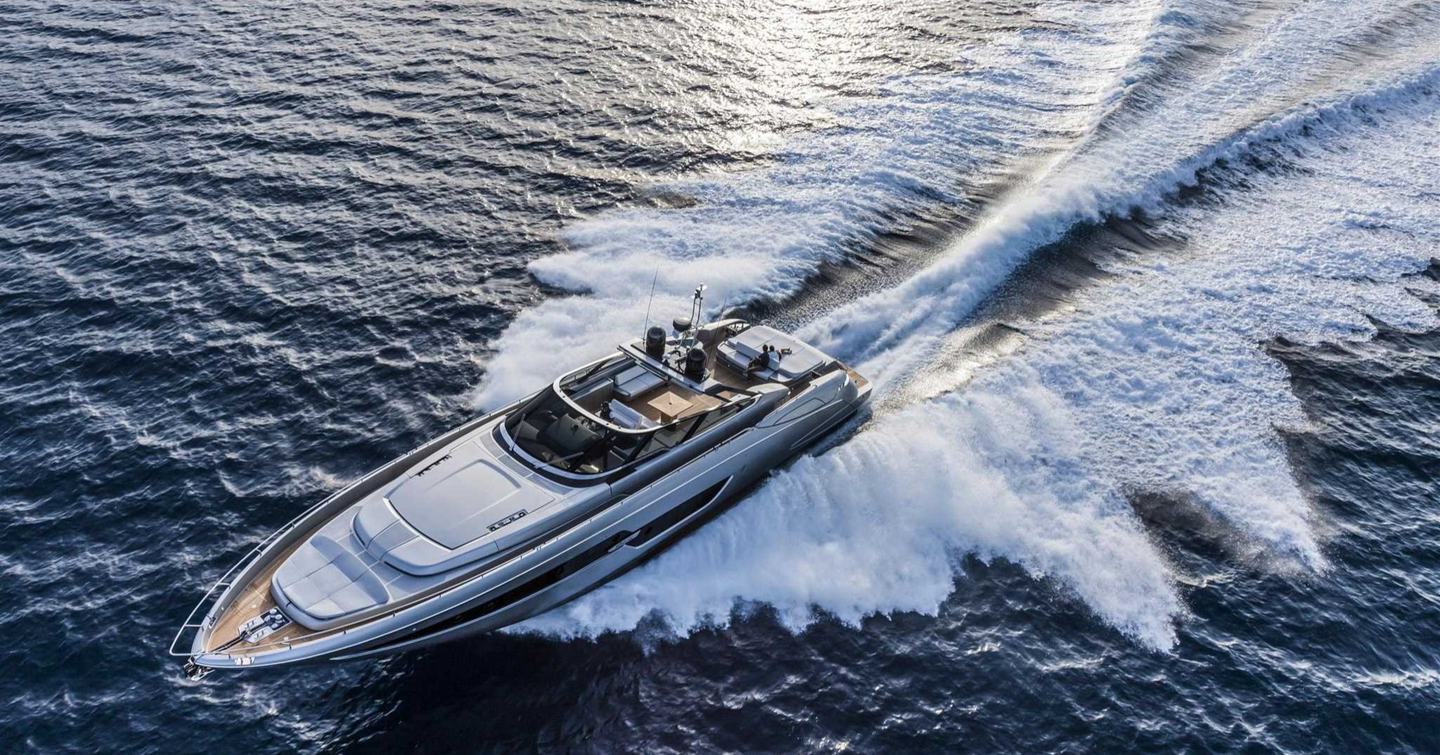
If a yacht owner is looking for a balance between speed and stability, the deep v-hull design is the next place to look. Designed to cut through the waves and provide a smoother ride even at high speeds. Offshore speed boats often feature deep v-hull designs, for tackling rough waters with ease.
What Yacht Hull Design is Best for Efficiency?
When considering efficiency in yacht design, the multihulls are an excellent choice. The twin-hull configuration of a catamaran offers reduced hull resistance with increased stability, thus making them highly efficient vessels. A catamaran will glide through the water with minimal drag, resulting in improved fuel efficiency.

If the environmentally friendly option is a yacht buyer's primary consideration or the maximum mileage for extended cruising, the multihull yacht design is the leader every time.
Seeking second place on the podium is the modern, modified vee planing hull designs, proving themselves to be fairly consistent in nautical miles per litre at their recommended planing speeds.
What Yacht Hull Design is Best for Rough Weather?
The deep v-hull yachts will handle rough weather with confidence. This yacht design is specifically designed to manage challenging seas with their deep, sharp V-shaped hulls cut through waves, providing a stable and comfortable ride, minimising the impact of waves and reducing the risk of capsizing,

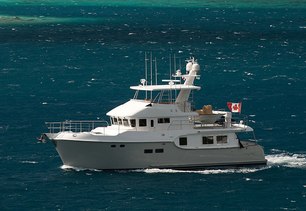
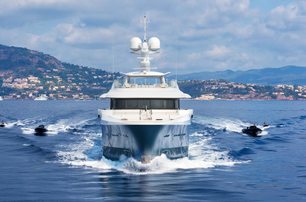
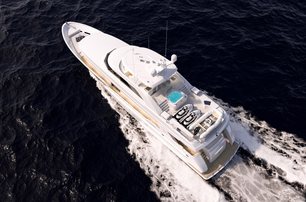
The displacement hull is a close second. Known for stability and seakeeping abilities, a displacement yacht is designed to move through the water with minimal resistance, resulting in a fairly comfortable and stable ride in a choppy sea.
